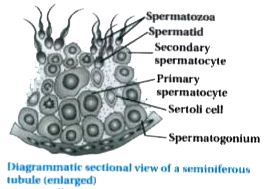Describe the process of spermatogenesis with labelled diagram.
In testis, the immature male germ cells produce sperms by spermatogenesis that begins at puberty.
Spermatogenesis is a continuous process. It has mainly two steps : (1) Formation of spermatids and (2) Spermiogenesis.
(1) Formation of spermatids : The germ cells which produce sperms are called primary spermatocytes. For the formation of these primary gametes sperms it passes through 3 phases.
(i) Multiplication phase : The spermatogonia present on the inside wall of seminiferous tubules multiply by mitotic division and increase in nucleus. Each spermatogonia is diploid and contains 46 chromosomes.

(ii) Growth phase : In this phase spermatoginum collects nutritive material and chromation in large amount. Each spermatogonium is also known as primary spermatocytes which take nutrition from the nutritive sertoli cells.
(iii) Maturation phase : Primary spermatocytes periodically undergo meiosis. A primary spermatocytes completes the first meiotic division leading to formation of two equal, haploid cells called secondary spermatocytes which have only 23 chromosomes each.
The secondary spermatocytes undergo the second meiotic division to produce four equal, haploid spermatids.
(2) Spermiogenesis : The spermatids are transformed into spermatozoa by the process called spermiogenesis.
After spermiogenesis sperm heads became embedded in the sertoli cells and are finally released from the seminiferous tubules by the process called spermiation.
Topper's Solved these Questions
- HUMAN REPRODUCTIONBOOK - KUMAR PRAKASHANCHAPTER - HUMAN REPRODUCTIONEXERCISE - SECTION-B (DIFFERENCE / SCIENTIFIC REASONS)
6 Videos
- HUMAN REPRODUCTIONBOOK - KUMAR PRAKASHANCHAPTER - HUMAN REPRODUCTIONEXERCISE - SECTION-B (GIVE SCIENTIFIC REASONS)
6 Videos
- HUMAN HEALTH AND DISEASE BOOK - KUMAR PRAKASHANCHAPTER - HUMAN HEALTH AND DISEASE EXERCISE - Section - F (Multiple Choice Question) (MCQs Asked In Competitive Exam))
33 Videos
- MICROBES IN HUMAN WELFARE BOOK - KUMAR PRAKASHANCHAPTER - MICROBES IN HUMAN WELFARE EXERCISE - SECTION - F MULTIPLE CHOICE QUESTIONS(MCQS ASKED IN COMPETITIVE EXAM)
56 Videos
Similar Questions
Describe the process of spermatogenesis in human male.
View SolutionDescribe the process of fertilization with a well-labelled diagram.
View SolutionWhat is spermatogenesis? Briefly describe the process of spermatogenesis.
View SolutionWhat is spermatogenesis? Briefly describe the process of spermatogenesis.
View Solution(a) Name the hormone that initiates spermatogenesis in humans. Describe the process of spermatogenesis in spermatogenesis in sequence mentioning the ploidy of the cells at each step.
(b) Draw the diagram of a mature human sperm and label the parts that : (i) helps it reaching to the ovum . (ii) providing energy for it to reach the ovum. (iii) helping it to gain entry into the ovum.
View Solution(a) Name the hormone that initiates spermatogenesis in humans. Describe the process of spermatogenesis in spermatogenesis in sequence mentioning the ploidy of the cells at each step.
(b) Draw the diagram of a mature human sperm and label the parts that : (i) helps it reaching to the ovum . (ii) providing energy for it to reach the ovum. (iii) helping it to gain entry into the ovum.
View SolutionDescribe the histology of testis with help of labelled diagram.
View Solution(a) Draw a diagrammatic labelled sectional view of seminiferous tubule of a human.
(b) Describe in sequence the process of spermatogenesis in human
View Solution(a) Draw a diagrammatic labelled sectional view of seminiferous tubule of a human.
(b) Describe in sequence the process of spermatogenesis in human
View SolutionDescribe the process of filtration with the help of a well-labelled diagram.
View Solution
